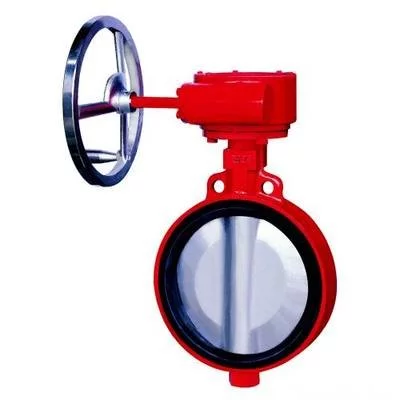Clip-on butterfly valve, also named as wafer butterfly valve is one of the most common valve types in industrial pipeline. Its structure is relatively small. It is only necessary to put the
butterfly valve in the middle of the flange at both ends of the pipeline, and use the stud bolt to lock the pipe flange and the clamp butterfly valve to control the fluid medium in the pipeline. The clamp type
butterfly valve is especially suitable for the places with narrow space or short distance between pipelines. When the
butterfly valve is in the fully open position, the thickness of butterfly plate is the only resistance when the medium flows through the valve body. Therefore, the pressure drop generated by the valve is very small. Then, it has good flow control characteristics.
 Installation instructions and steps of wafer butterfly valve:
Installation instructions and steps of wafer butterfly valve:
I. Pre-installation of clip-on butterfly valve:
1. Before installation and operation, clean the pipe with air and clean the inner surface with water.
2. Carefully check whether the service condition of the valve is consistent with its performance specification. (temperature and pressure)
3. Check whether there are impurities in the valve channel and sealing surface, and remove them in time.
4. After unpacking, the valve should be installed in time. Do not loosen any fastening screws or nuts on the valve at will.
5. Special flange of
butterfly valve must be used for
wafer type butterfly valve.
6.
Electric butterfly valve can be installed in any angle of the pipeline. In order to facilitate maintenance, it is recommended not to install upside down.
7. During the installation of
butterfly valve flange, it must be ensured that the flange face and the sealing rubber are aligned. The screws are evenly tightened, and the sealing surface must fit completely. If the screw tightening force is not uniform, rubber bulge will block the butterfly plate, or the valve rod will leak due to the sticking of the butterfly plate.
II. Installation steps of wafer butterfly valve:
The correct installation of
wafer butterfly valve is related to the sealing degree of
butterfly valve and whether it will leak or not, including the safety in operation under working conditions. Users should understand the installation process.
1. Place the valve between the two pre-installed flanges. Pay attention to the alignment of bolt holes.
2. Insert four pairs of bolts and nuts into the flange hole, and tighten the nuts slightly to correct the flatness of flange surface.
3. Fix the flange on the pipe by spot welding.
4. Remove the valve.
5. The flange shall be completely welded and fixed on the pipe.
6. Install the valve after the weld joint is cooled. Ensure that the valve has enough movable space in the flange to prevent the valve from being damaged, and ensure that the valve plate has a certain opening degree.
7. Correct the position of the valve and tighten the four pairs of bolts.
8. Open the valve to ensure that the valve plate can open and close freely, and then slightly open the valve plate.
9. Tighten all nuts evenly across.
10. Make sure that the valve can open and close freely. Note: make sure that the valve plate does not touch the pipe.
The installation of
wafer butterfly valve must be placed horizontally before installation, and it must not be bumped at will. After it is drawn to the installation length during the installation. In the field pipeline design, it is not allowed to dismantle the clip type butterfly valve without special permission. This is what we need to know before installation. At the same time, we should also know that the double clip butterfly valve can be installed in any position, but after the installation of the clip type butterfly valve, the butterfly valve needs to be laid along the line. Once the bracket is made, it is strictly forbidden to remove the bracket when using it.
